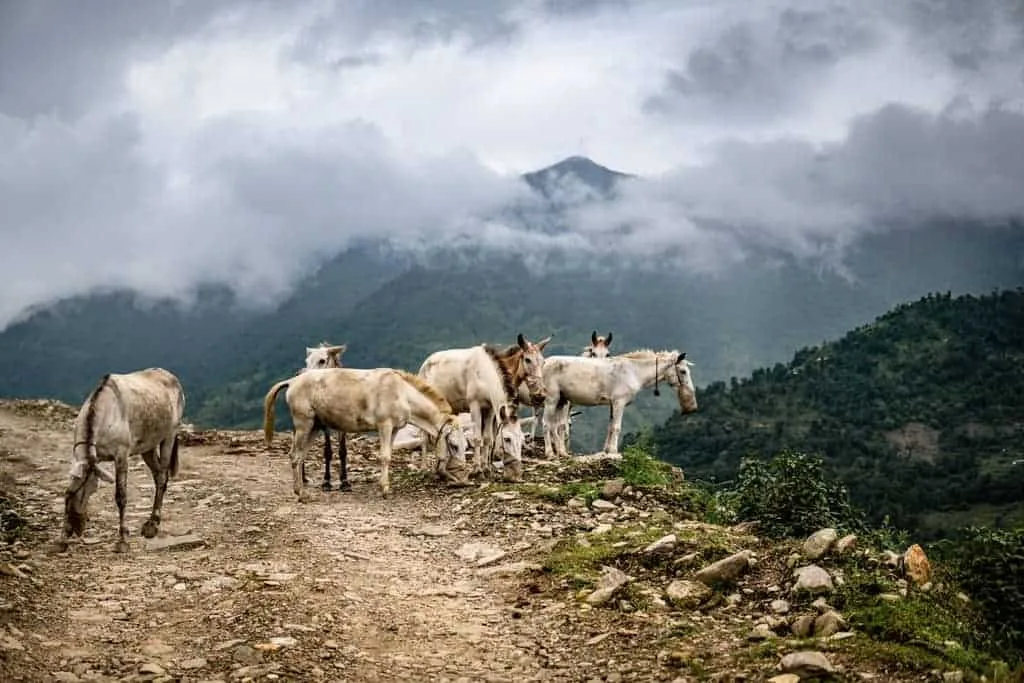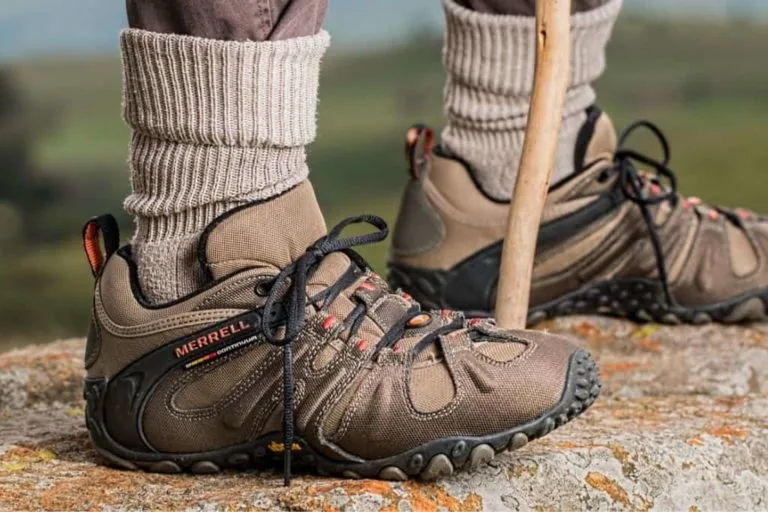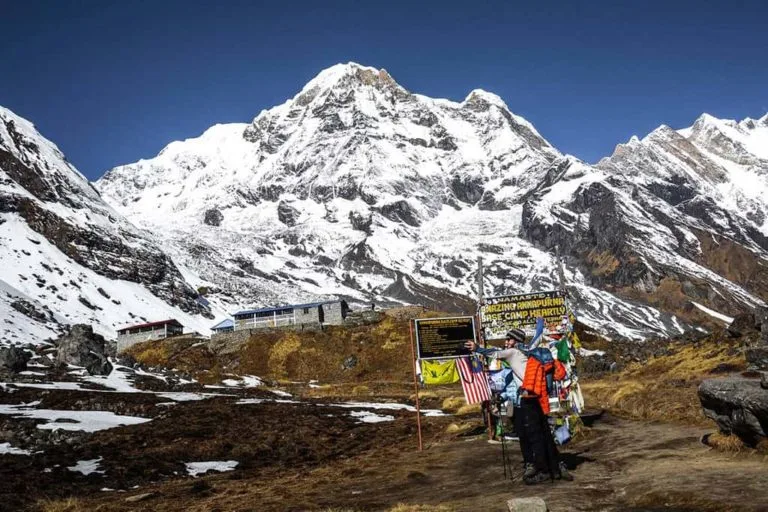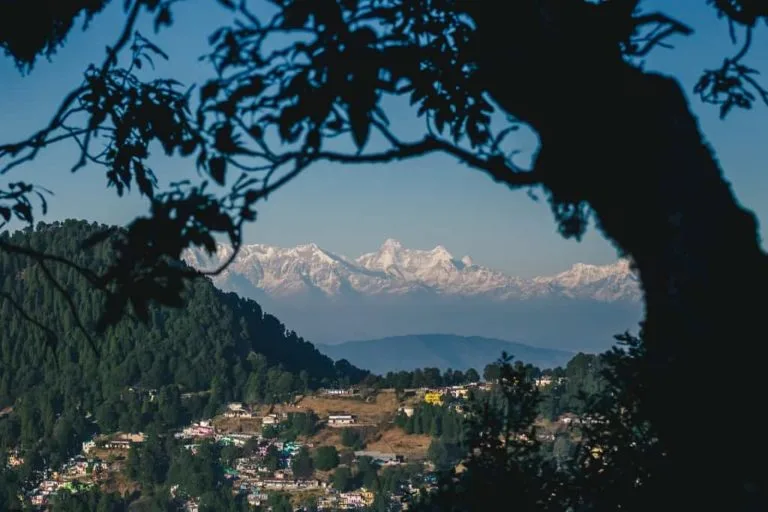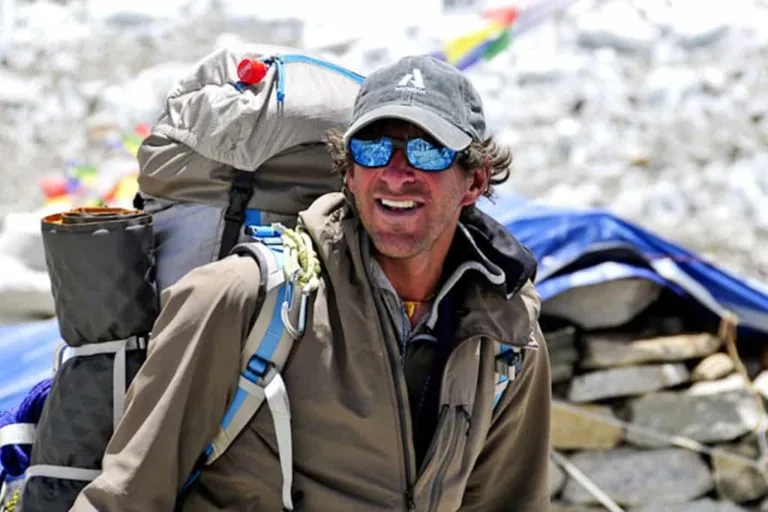Top 13 Best Treks in Nepal
Nepal, a country blessed with the majestic Himalayas, diverse landscapes, and culture. It is an adventurer’s playground.
The country provides a wide range of outdoor activities like mountaineering, rafting, jungle safari, ziplining, and more, but trekking is one activity that Nepal is most famous for.
Nepal invites more than 200,000 trekkers every year to explore the Himalayan vicinity. The country is the best trekking destination as it gives multiple options for intrepid trekkers seeking a challenge and those looking for gentle walks, all the while enjoying the beautiful sceneries and culture of the country.
We have listed the Top 13 best trekking destinations in Nepal, which will give you an idea about which ones to add to your bucket list and the reasons.
1. Best treks in Nepal: Everest Base Camp trek

The Everest Base Camp is the number one trekking destination in Nepal. The challenging trek takes you to the base camp of the tallest mountain in the world.
The Everest Base Camp trek offers you breathtaking views of the Himalayan cliffs, glaciers, and forested hills. You will walk through the picturesque Sherpa villages of the Everest region.
The flight from Kathmandu to Lukla in itself is a fantastic experience as it gives you a combination of thrill and breathtaking Himalayan views, all in your 30-minutes flight.
Your time at the Sherpa capital– Namche Bazaar, will give you a cultural experience as you get to explore the village and learn about the mountain people’s livelihood and religion.
Upon reaching the Everest Base Camp, you will be surrounded by the views of some of the highest mountains of Nepal like Cho Oyu, Lhotse, Ama Dablam, Nuptse, Makalu, and so on.
On your descent, you will visit Kala Patthar– the highest point of the Everest Base Camp trek from where you will see beautiful sunrise uncovering the best views of Everest, Makalu, Lhotse, and many other peaks.
The trek can be done in a Helicopter if you do not want to trek up and down the base camp. It is an excellent option if you have limited time.
Max Elevation: 5,600 meters (Kala Patthar)
Trek Duration: 14 days
Trek Category: Moderate – Challenging
Best Season: March-May, October – November
2. Best treks in Nepal: Annapurna Circuit Trek
The Annapurna region welcomes more than 100,000 trekkers every year to trek its vicinity. One of the best ones is the Annapurna Circuit Trek, which invites 50,000 trekkers worldwide every year.
The Annapurna Circuit trek is a blissful trek that takes you through the foothills of the entire Annapurna range and shows the breathtaking views of the highest peaks like the Annapurna II, Annapurna III, Lamjung, Dhaulagiri, and more.
You will pass by some beautiful villages like Braga, Manang, Jomsom, and Marpha inhabited by Gurung and Magar people. This trek is excellent for cultural learning, as you will be in touch with these people throughout the walk.
Annapurna Circuit Trek takes you to Nepal’s famous Hindu-Buddhist temple, Muktinath, and other stupas.
Another highlight of the trek is crossing the Thorong La Pass, one of the highest passes in the world, from where you will witness the panoramic views of the Himalayan peaks that go as far as the north of Tibet.
On your decline, you will get to witness the stunning view of the Annapurna range from Poonhill and relax your muscles at a natural hot spring of Tatopani.
Max Elevation: 5,416 meters (Thorong La Pass)
Trek Duration: 14 days
Trek Category: Challenging
Best Season: March-May, October – November
3. Best treks in Nepal: Annapurna Base Camp Trek
Annapurna Base Camp Trek is another most popular hiking itinerary of Nepal.
It is famous for trekkers due to its diverse scenic beauty, spectacular mountain views, and cultural interaction. It is also popular due to its accessibility. Trekkers can begin their adventure by traveling from Kathmandu to Pokhara on an 8-hours drive or a brief flight.
The trek’s trail takes you through several picturesque villages decorated by terraced farms, monasteries, and temples. You will get an insight into the mountain culture characterized by both Buddhism and Hinduism.
The hospitality of the Magar and Gurung people residing in the area will flatter you.
You will walk through dense forests of rhododendron, pine, and bamboo and trek to Machhapuchhre Base camp, where you will see the fantastic views of Himchuli and Gangapurna peaks.
Upon reaching the Annapurna Base Camp, you will be rewarded by the views of encircling walls of mountains. Since the base camp is located near the Annapurna Sanctuary, you will stand directly in the shadow of the mighty mountains like Machhapuchhre, Dhaulagiri, Annapurna South Annapurna I. Now that is a scene you will never forget.
On your descent, you will visit Poon Hill (3,210 m)– a viewpoint from where you will enjoy the panoramic views of the Himalayas.
Max Elevation: 4,310 meters
Trek Duration: 11-14 days
Trek Category: Moderate – Difficult
Best Season: March-May, September – December
4. Best treks in Nepal Langtang Valley Trek
Nepal is no short of trekking destinations; the Langtang Valley trek is one of them. The 8-10 days trek starts after an 8-hour drive from Kathmandu to Syabrubesi. From here on, you will start your walk through pine forests, streams, meadows, and vast pastures.
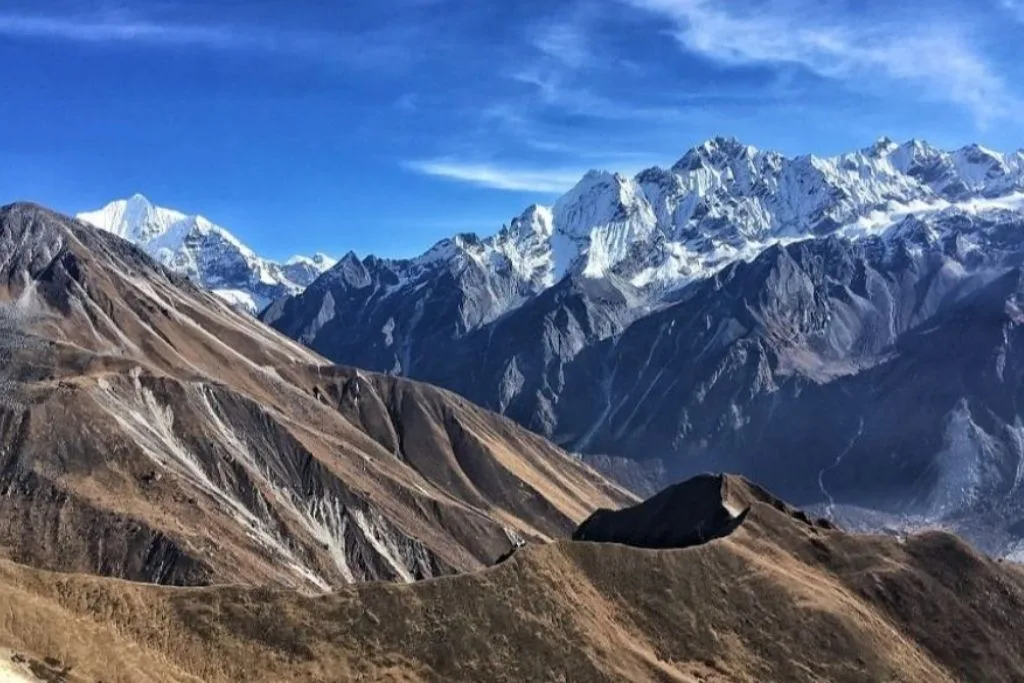
The trek involves walking through wooded valleys and flowing rivers and traversing high ridges that ascend to sheer ice walls.
The trek will show you astounding views of the mountain peaks like Langtang, Lirung, Langtang Ri, and Dorje Lakpa. You might even encounter some of the rarest animals like the arboreal red panda, Himalayan tahr, musk deer, and snow leopard.
The Langtang Valley trek is even more exciting for birdwatchers as the trail passes through the Langtang National park, which houses hundreds of bird species.
Besides the natural diversity, the Langtang Valley trek has cultural and religious significance too. You will meet locals of Tamang, Newari, and Sherpa ethnicity influenced by the Tibetan-Buddhism religion.
You will visit the Kyanjin Gompa, which lies against an incredible backdrop of Himalayan summits and is covered with colorful prayer flags that will make you feel peaceful.
You will watch the beautiful sunrise from Tserko Ri and visit the yak farms and cheese factories.
Max Elevation: 4,984 meters (Tserko Ri)
Trek Duration: 8 – 10 days
Trek Category: Moderate
Best Season: March-May, October – November
5. Best treks in Nepal: Manaslu Circuit Trek
Manaslu Circuit Trek is a hidden gem that is considered one of Nepal’s best, spellbinding, and crowd-free treks. The trek takes you around Mount Manaslu, the 8th highest peak of Nepal.
In this trek, you will walk through Manaslu valley’s wild landscapes with lush jungles to even high-altitude mountain passes. You will traverse beautiful villages inhabited by the region’s major ethnic groups: Nurbi, Tsum, and Gurung. You will experience the local’s practices and learn about their history.
The Manaslu Circuit Trek also includes a visit to the Ribung Gompa, where you will discover a handful of religious artworks and see monks in their everyday life. A visit here is an excellent opportunity to understand the deeper meaning of the Buddhism religion.
The best part of the trek is reaching the high-altitude pass of Larkya La, from where you will see the panoramic views of Himlung Himal, Cheo Himal, Kang Guru, and Annapurna II.
Manaslu Circuit Trek is genuinely the best combination of natural and cultural splendor.
Max Elevation: 5,160 meters (Larkya Pass)
Trek Duration: 14 days
Trek Category: Difficult
Best Season: March-May, September-December
6. Best treks in Nepal: Upper Mustang Trek
The trek to the forbidden kingdom; a place untouched by modernization and filled with only remoteness and natural beauty; now is something every trekker and a nature lover looks forward to.
The Upper Mustang Trek takes you on a walk to a desert-like landscape with high walls with rigid mountains’ views.
Besides the landscapes, the hidden caves and the historical monasteries are something that fascinates every trekker.
You will see incredible mountain views of the Nilgiri, Annapurna, and Dhaulagiri, to name a few. On your trek, you will also visit Lo Manthang—the capital of Lo’s kingdom.
Not to forget, you will meet the locals—Lobas, who are the descendants of Tibet and learn about the Tibetan-Buddhism culture.
Max Elevation: 3,810 meters (Dhakmar)
Trek Duration: 14 days
Trek Category: Moderate- Difficult
Best Season: March – December
7. Best treks in Nepal: Kanchenjunga Circuit Trek
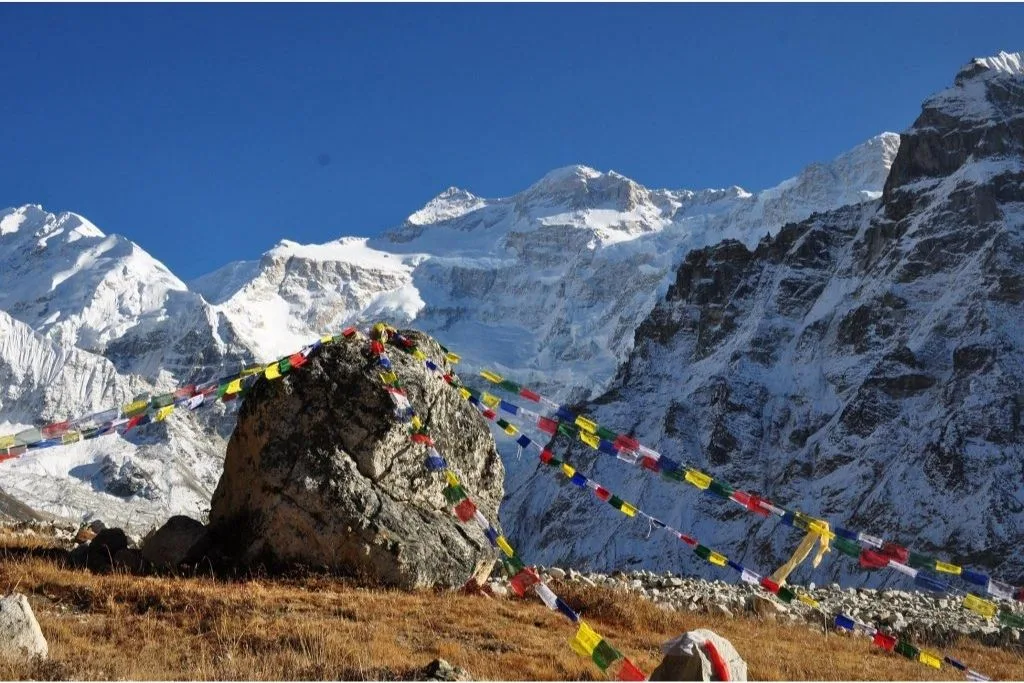
Kanchenjunga Circuit Trek is one of the most famous treks of Nepal. It takes you to both the north and south base camps of Mount Kanchenjunga – the world’s third-highest mountain peak.
Every trekker will have a mesmerizing time as they walk the trails with no traffic. Kanchenjunga Circuit Trek is a long trek into the region’s remoteness that rewards you with breathtaking views of Mount Kanchenjunga, rivers, waterfalls, and the rhododendron forests.
Walking the trails while overlooking these picturesque landscapes would be an eye-pleasing experience.
You will also be exploring the Kanchenjunga Conservation Area, where you will be amazed by the wildlife and natural heritage that are beautifully conserved. You can sightsee rare animals like snow leopard, red panda and black bear; and birds like pheasants.
You will also learn about the cultures and traditions as you pass through the Rai and Limbu tribes’ villages.
Another highlight of the trek is crossing the three high passes: Sinion La (4,400m), Mirgin La (4,480m), and Sinelapche Bhanjyang (4,636m). You will see splendid views of Mount Kanchenjunga and Mount Makalu from these passes.
Max Elevation: 4,636 meters (Sinelapche Bhanjyang)
Trek Duration: 23 days
Trek Category: Strenuous, Difficult
Best Season: March-May/ October -December
8. Best treks in Nepal: Makalu Base Camp
A trek to the base camp of the world’s fifth tallest mountain, Makalu, is the best experience you will have in your lifetime. The walk sure is challenging due to its high altitude trekking.
On the contrary, the Makalu Base Camp rewards you with its vibrant rhododendron forests, granite cliffs, glaciers, and waterfalls.
You will pass through terraced farms of the people living in this region. Sherpas reside in the higher mountainous terrains, whereas Rai’s reside in the lower elevations. You will be learning about Buddhism and Kirati culture en route to the base camp.
As you reach the base camp, you will be awed by the majestic mountains’ spectacular views like the Makalu, Everest, Kanchenjunga, Lhotse, and Baruntse. You will also see the eastern face of Mount Everest– the Kangshung face, from the trails.
Another part that excites every trekker is crossing the high passes like Shipton La and Keke La on the way to Makalu Base Camp.
Plus, walking through the Makalu Barun National Park is also rewarding as you will be surrounded by rich flora and fauna. You might even see exotic animals like the musk deer, red panda, and snow leopard.
Max Elevation: 5,250 meters (Shersung Ridge)
Trek Duration: 19 days
Trek Category: Difficult
Best Season: March-May, October-November
9. Best treks in Nepal: Gokyo Valley Trek
The Gokyo Valley trek takes you to the five emerald green lakes of the Gokyo region. It is deemed as one of the best treks in Nepal.
You will traverse through the forests filled with rhododendron, oaks, and other plant species to reach the valley. As you arrive at the Gokyo valley, you will be welcomed by the iced lakes, glaciers, and even the waterfalls.
Due to the lakes’ existence, Gokyo valley preserves the highest altitude wetlands and freshwater lakes systems.
The trek also takes you to Gokyo Ri– the best viewpoint that provides the Himalayas’ splendid views. You will also see the Ngozumpa glacier– the world’s biggest ice glacier.
You will spend time exploring the Gokyo village and learn about the Tibetan-Buddhist-Sherpa culture. Also, a visit to some of the valley’s antique monasteries is a must.
The trek can be done as a part of the Everest Base Camp trek as well.
Max Elevation: 5,357 meters (Gokyo Ri)
Trek Duration: 12 days
Trek Category: Difficult
Best Season: March-May, October – November
10. Best treks in Nepal: Mardi Himal Trek
The Mardi Himal Trek takes place in the Annapurna region. Yes, Annapurna again.
The region is definitely rich in natural beauty, and most of the trekkers come here to be a part of the Annapurna Base Camp trek or the Annapurna Circuit Trek. But the real adventure lies at Mardi Himal– a hidden gem shadowed by other Annapurna treks.

The Mardi Himal trek takes you on a walk through picturesque villages and terraced fields. Trekkers have the best time traversing the lush jungles and walking along the flowing rivers of glacier meltwater. You will meet locals of the Annapurna region, who are unbothered by the city life.
Encountering several bird species and animal species, Danphe and Red panda being the most sought-out species, is a memorable experience.
You will see excellent views of the Mardi Himal, Fishtail, Annapurna, and Himchuli peaks on your trek.
The stunning hills and mountain landscapes are just another icings on the cake.
Mardi Himal Trek is for travelers who have limited time and want unspoiled alpine bliss in the Annapurna region but without human traffic.
Max Elevation: 4,250 meters
Trek Duration: 7 days
Trek Category: Easy
Best Season: March-May, September – December
11. Best treks in Nepal: Dhaulagiri Circuit Trek
Trekking the Dhaulagiri Circuit is one of the most challenging yet most rewarding experiences in Nepal. It is an unforgettable adventure that is only suitable for experienced trekkers due to its elevation. You will be spending three days trekking over 5,000m.
Besides, your trails will also take you through farming villages, deep valleys, and alpine pastures.
You will see amazing close-up views of the towering Himalayas as well. What’s better is that it is a lesser-known high-altitude trek, which means you will have less crowd on the trails.
One of the major highlights of the Dhaulagiri Circuit trek is that you’ll reach the base of the seventh-highest mountain in the world, Dhaulagiri, along the Chhonbardan Glacier.
Max Elevation: 5,360m (French Col)
Trek Duration: 14 days
Trek Category: Very challenging
Best Season: September-November
12. Best treks in Nepal: Nar Phu Valley Trek
Nar Phu Valley trek is another challenging trek that takes you on an unforgettable journey to one of the remote areas of Nepal. The valley is located between two famous trekking regions: Annapurna and Manaslu.
This trek lets you explore the unspoiled valleys and old Tibetan Buddhist culture. The stunning views of the Annapurna II, Tilicho, and Gangapurna make the trekking experience better.
Max Elevation: 5,416m
Trek Duration: 12-15 days
Trek Category: Very challenging
Best Season: March-May or September-November
13. Best treks in Nepal: Upper Dolpo Trek
Upper Dolpo is a hidden gem in Nepal that boasts Tibetan-style villages, barren landscapes, fertile rice terraces, and towering peaks. The region is still untouched by the modern world and holds centuries-old culture.
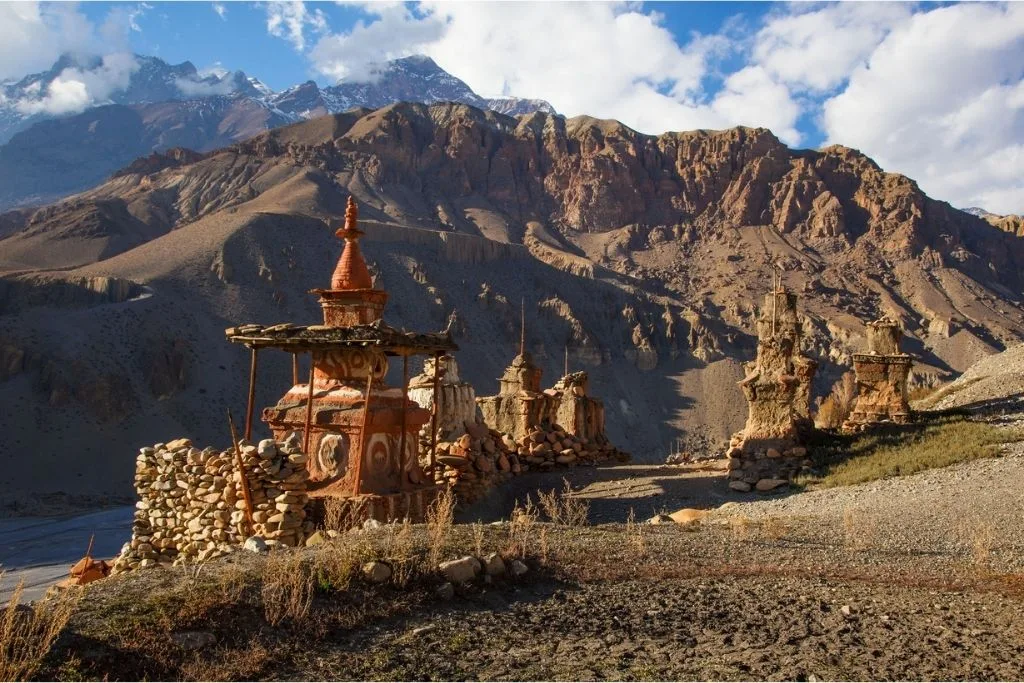
It is a challenging trek that requires long climbs and steep descents. You will be traversing the three high passes, such as Nagdalo La (5350m), Jeng La (5110m), and Shey La (5000m).
You will have a fantastic time taking in the views of the Kanjirowa mountain.
Max Elevation: 5,250m (Kang La Pass)
Trek Duration: 22 days
Trek Category: Moderate-Challenging
Best Season: March-May or October-November
FAQs
How to get a visa for Nepal?
You can get the visa at the Tribhuvan International Airport. For this, you need to present the following documents:
- Passport of 6 months validity
- Passport-size photo.
- Visa fee of USD 50 for 30 days, which needs to be paid in cash.
If you want to extend your stay in Nepal, you can go to the Central Immigration Office and fill out the forms and pay.
If you are a citizen of the SAARC countries or China, you will receive a free visa. Indian citizens do not require a visa to travel to Nepal.
If you are a citizen of Ghana, Nigeria, Somalia, Iraq, Cameron, Swaziland, Palestine, Liberia, and Afghanistan, you will not receive the visa on arrival to Kathmandu. You need to contact your local Nepalese embassy before flying to Kathmandu.
Do I need travel insurance to travel to Nepal?
Yes, it would be best if you had travel insurance for traveling to Nepal.
You need a travel insurance policy covering all the injuries or emergency costs you may face during the trek.
The travel insurance policy must include the cost of helicopter evacuation and hospitalization, incase of an emergency. Also, try to choose an insurance company that provides coverage on domestic and international flight cancellations as you may face flight cancellations due to weather conditions.
You have to provide your travel insurance certificate’s copy to the travel agency. Failure to present an insurance policy or even an improper insurance policy will lead to the cancelation of your trip.
The agency will use your insurance policy information to arrange a quick and effective rescue operation in case of need.
What is the best time to trek in Nepal?
The best time to trek in Nepal is in the Spring (March-May) and Autumn (September – November) seasons. These are the times when the trails are dry, and the skies are clear. Due to the right weather conditions, the mountains are visible, and the trails will also blossom with greenery.
Trekking in the monsoon will have rain clouds, due to which it won’t be easy to explore the scenic beauty of the area entirely. However, in the Upper Mustang Trek’s case, trekking in Monsoon (June – August) is favorable.
Should I bring trekking gear?
It would be best if you plan and bring trekking gear with you. If not, then Nepal also has many stores in Thamel, Kathmandu, and Lukla, where you can buy trekking gear.
Will I be carrying my gear?
If you are traveling with a porter, you will only carry a daypack, including your essentials.
Your luggage, including your clothes, sleeping bag, and trekking gear, will be carried by the porter.
How much luggage to carry?
A trekker should carry luggage of a maximum of 9kgs. A porter will be assigned to carry your luggage. If you are traveling in a group, he will be carrying another trekker’s luggage. So the combined weight of the bags would be 18 kgs. The porters shouldn’t carry more for safety reasons.
Carry only your valuables and what is necessary for your backpack. Leave your excess baggage at the hotel.
How to get trekking permits?
Your travel/trekking agency will obtain the necessary trekking permits on your behalf, so you need not worry.
Can you trek without a guide?
Yes, you can trek without a guide in most of the trekking spots. However, some areas like the Manaslu Circuit, Narphu, Upper Mustang, Kanchenjunga, and Upper Dolpo are restricted to be traveled alone.
Guides are mandatory to obtain permits in such areas.
Is Nepal safe to travel to?
Yes, Nepal is relatively safe. The only risk factor during the trek in Nepal is the weather conditions. But worry not, as the trekking agency will be up-to-date with the weather conditions of the region you will be trekking at and will take complete precautions to keep you safe.

